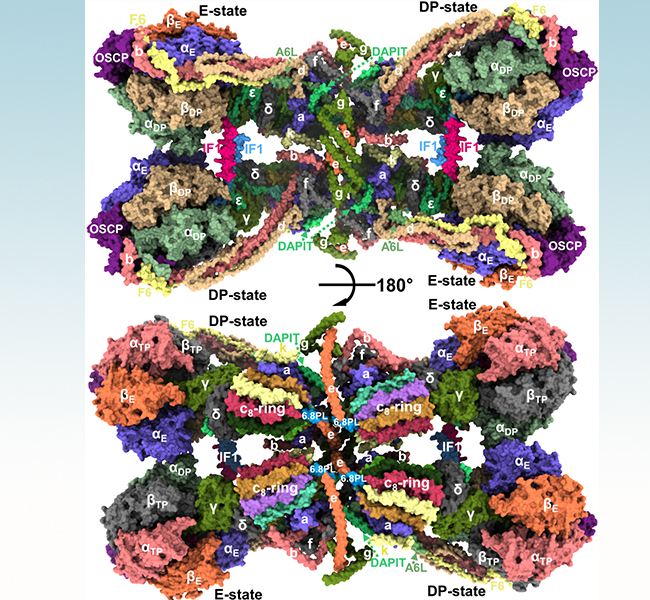Maojun Yang’s group published a research article in Science on Cryo-EM structure of the mammalian ATP synthase tetramer bound with inhibitory protein IF1
Professor Maojun Yang’s group at Tsinghua University, School of Life Sciences published a research article in Science on 14th June, 2019 entitled "Cryo-EM structure of the mammalian ATP synthase tetramer bound with inhibitory protein IF1". In this work, Prof. Yang’s group isolated porcine tetrameric ATP synthase and solved its structure at 6.2 A resolution using a single-particle cryo-electron microscopy method. Within the tetramer, they refined structures of intact ATP synthase in two different rotational conformations at 3.34- and 3.45-A resolution.

Cryo-EM structure of a porcine ATP synthase tetramer
F1FO adenosine triphosphate (ATP) synthases are molecular motors that enable conversion of energy from a proton gradient to the high-energy terminal phosphodiester bond of ATP. The overall architecture of this multipart enzyme is conserved from bacteria to the mitochondria of eukaryotes. Oligomerization of ATP synthase is proposed to be involved in the formation of cristae in mitochondria. Yet, what is the specific composition of the mammalian ATP synthase and how the oligomerization is established remain elusive. Through high performance Cryo-EM technology, Prof. Yang’s group solved the intact ATP synthase structures in two different rotational states with 30 subunits in total (19 different types). And the Interactions within the ATP synthase tetramer were identified.
Professor Maojun Yang is the corresponding authors of this work. Post-doc Jinke Gu, Ph.D. student Laixing Zhang, Post-doc Shuai Zong and Ph.D. student Runyu Guo are the co-first authors. Ph.D. student Tianya Liu, Jingbo Yi, Post-doc Wei Zhuo and Prof. Peiyi Wang contributed to this work. All data collection is supported by the Cryo-EM Facility Center of Southern University of Science and Technology (Shenzhen). Data processing is completed on the Yanglab GPU workstation. Special thanks to Prof. Peiyi Wang, director of the Cryo-EM Facility Center of SUSTC. This work was supported by funds from the National Key R&D Program of China (2017YFA0504600 and 2016YFA0501100). The National Science Fund for Distinguished Young Scholars (31625008), and the National Natural Science Foundation of China (21532004, 31570733 and 31800620). The China Postdoctoral Science Foundation (2017M620040 and 2018T110091).
Original Publication: https://science.sciencemag.org/content/364/6445/1068
Reference: https://www.nature.com/articles/nature11541
https://doi.org/10.1038/nature19359;
https://www.cell.com/cell/fulltext/S0092-8674(16)31533-1
https://www.cell.com/cell/fulltext/S0092-8674(17)30887-5
https://link.springer.com/article/10.1007%2Fs13238-018-0515-x
http://dx.doi.org/10.1038/s41422-018-0071-1
Source: School of Life Sciences
Editor: Guo Lili

